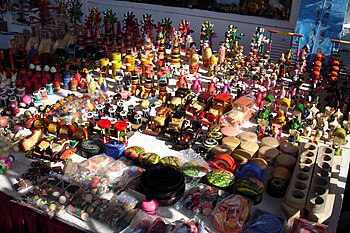Channapatna toys are a particular form of wooden toys and dolls that are manufactured in the town of Channapatna in the Ramanagara district of Karnataka state, India. This traditional craft is protected as a geographical indication (GI) under the World Trade Organization, administered by the Government of Karnataka.[1] As a result of the popularity of these toys, Channapatna is known as the Gombegala Ooru (toy-town) of Karnataka.[2] Traditionally, the work involved lacquering the wood of the Wrightia tinctoria tree,[3] colloquially called Aale mara (ivory-wood).[4]

History
editThe greater prominence of the Channapatna toys can be traced to patronage from Tipu Sultan, the historic ruler of Mysore, though these toys existed before this period historically given as gifts as part of Dusshera celebrations. It is known that he was an ardent admirer of arts, and in particular of woodwork.[5] The art underwent dramatic changes over the years. Later, a man by the name of Bavas Miyan[6] undertook the responsibility to introduce Japanese doll making techniques to improve production and reduce the effort that went into making each piece of toy. For nearly two centuries, ivory-wood was the main wood used in the making of these toys, though rosewood and sandalwood were also occasionally used. [citation needed] P Mohamed Ilyas who is a colours expert for toys (master of colourful toys) has innovated colours based on themes and international seasons to create a market for the Channapatna artisans community.
Manufacturing
editThe craft has diversified over time; in addition to the traditional ivory-wood, other woods—including rubber, sycamore, cedar, pine and teak—are now used as well.[7] Manufacturing stages include procuring the wood, seasoning the wood, cutting the wood into the desired shapes, pruning and carving the toys, applying the colours and finally polishing the finished product. Vegetable dyes are used in the colouring process to ensure that the toys and dolls are safe for use by children.[2] As of Oct 2011, Channapatna had a population of 71,902,[8] in which 254 in home manufacturing units and 50 in small factories, were engaged in the making of these toys. The Karnataka Handicrafts Development Corporation (KHDC) provides assistance with marketing efforts. The oldest and most popular manufacturing unit Bharath art and crafts help develop innovative products.[2]
Growth
editWith no proper back up or marketing, the Channapatna toy industry faced a financial crunch for more than a decade[when?] and was almost on the verge of dying out.[7] However, with the help of KHDC, the craft has been revived and the artisans involved are being trained on changing trends in the industry, to help them keep a breast of the current scenario. Prototypes designed by master craftsmen are introduced to the local artisans, who use them to create well-designed toys and dolls. The Government of Karnataka has also provided help by constructing a Lacquerware Craft Complex, which has a manufacturing centre with 32 turning lathe machines.[7] Financial assistance to the artisans, with help from the Dutch Government and the Karnataka Government's Vishwa scheme has also been provided.
Many new companies and social enterprises have been reviving the Channapatna craft to suit modern tastes.[9] iFolk Channapatna toys and handicrafts, few manufacturing units promotes and supports lacquerware artisans to do innovation and modernisation of their products. [7] In 2022, KSR Bangalore City railway station set up a dedicated stall for the toys as a pilot study.[10]
See also
editReferences
edit- ^ GI for Channapatna toys and dolls is mentioned by P. Manoj (19 February 2006). "GI certificate for Channapatna toys, Bidriware, Coorg orange". The Hindu. Chennai, India. Archived from the original on 10 June 2007. Retrieved 22 April 2007.
- ^ a b c A brief history of Channapatna toys is provided by Govind D. Belgaumkar and Anil Kumar Sastry (27 October 2006). "Unique symbols of Karnataka". The Hindu. Chennai, India. Archived from the original on 10 February 2007. Retrieved 22 April 2007.
- ^ "Chapter 3: Case Study 2 – LAC-Turnery and the Lacquerware Industry".
- ^ A brief description of Channapatna toys is provided by National Informatics Centre. "Industries and Commerce, Bangalore Rural district". Official Webpage of the Bangalore Rural district. Government of Karnataka. Archived from the original on 18 May 2007. Retrieved 22 April 2007.
- ^ Handmade in India: A Geographic Encyclopedia of Indian, Page 362, Aditi Ranjan, M. P. Ranjan (2009)
- ^ "History Of Channapatna Toys". Craftdeals.in. Craftdeals.in. January 2023. Retrieved 1 January 2023.
- ^ a b c d A detailed summary of Channapatna toys is provided by Azmathulla Shariff. "Toy town changes with new trends". Online Edition of The Deccan Herald, dated 2005-03-29. 2005, The Printers (Mysore) Private Ltd. Archived from the original on 20 April 2007. Retrieved 22 April 2007.
- ^ "Channapatna City Municipal Council City Population Census 2011-2020 | Karnataka". www.census2011.co.in. Archived from the original on 24 November 2019. Retrieved 16 May 2020.
- ^ Pavitra Jayaraman (20 April 2013). "Channapatna, Karnataka – Back in the game". livemint.com.
- ^ "Now buy Channapatna toys at Bengaluru railway station". Hindustan Times. 25 March 2022. Retrieved 14 August 2022.
